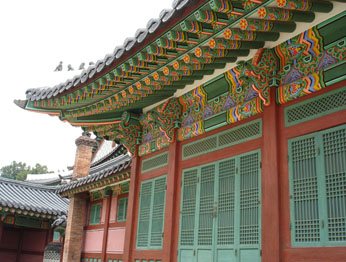CHANGDEOKGUNG PALACE

Sharp Travel & Tours Inc.
Contact Info
Telephone - 847.759.8813
Toll Free - 1.888.To.Sharp
Email - sharptour@hotmail.com

Changdeokgung was built in the 5th year (1405) of the reign of King Taejong of the Joseon Dynasty, as a separate palace of Gyeongbokgung, the original main palace of the dynasty. Located to the east of Gyeongbokgung, it has also been called Donggwol, the east palace. Gyeongbokgung and Changdeokgung were burned down during the Japanese invasion of Korea in 1592. Changdeokgung was reconstructed in 1609 and served as the royal seat for 300 years until the reconstruction of Gyeongbokgung at the end of the Joseon Dynasty.
Overall, Changdeokgung is divided into administrative quarters, residential quarters and the rear garden. The existing administrative quarters encompass Donhwamun, the front gate, which is the oldest existing palace structure, Injeongjeon, the throne hall, and Seonjeongjeon, the administrative hall. The residential quarters include Huijeongdang and Daejojeon, the king's and queen's bedchambers, the royal kitchen, the infirmary and other annexes. The rear garden has exquisite pavilions, the court archives, a library and lotus ponds.
Changdeokgung is well tuned to its natural backdrop of hilly terrain and lush woods. Taking advantage of the surroundings, the palace's magnificent halls, pavilions, and rear garden are laid out in a rather liberal way, which makes it a landmark of palace architecture and garden landscaping.
The rear garden is adorned with precious trees, of which some are now 300 years old. It represents the zenith of Korean garden landscaping techniques. The royal family and court functionaries enjoyed here both reposeful moments and garden entertainment here.
For the unique configuration of its palatial buildings and its rear garden, showing an ideal example of Oriental architecture yet quite distinct from the Chinese Zijin-cheng Palace, Forbidden Palace, or the Japanese imperial palace, Changdeokgung was registered on UNESCO's World Cultural Heritage List in December 1997.
Justification for Inscription:
The Committee decided to inscribe this property on the basis of criteria (ii), (iii) and (iv), considering that the Ch'angdokkung Palace Compound is an outstanding example of Far Eastern palace architecture and garden design, exceptional for the way in which the buildings are integrated into and harmonized with the natural setting, adapting to the topography and retaining indigenous tree cover.
Please visit www.unesco.org for more information about UNESCO.
UNESCO Properties of Korea
© 2008 Sharp Travel and Tours Inc.